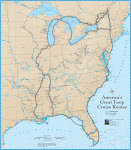 |
| Laurie and granddaughter Emerson |
 |
| At the fort, the furnace was used to heat cannon balls which would then be shot out at wooden ships offshore. |
 |
At Jay and Laurie's house, Jim, Jay, Laurie, myself and Wayne
|
 |
| The entrance to Fort Macon. The walls of the fort were built of brick, but the union bombardment used rifled cannon shot which was able to break down the brick walls. Brick walls were not used for building forts again. |
Cooler this morning, in the high 50s when we got up; we haven't seen temperatures this cool since last fall. Had a visit with Michael, Jennifer, Daria and Keenan on Muddy Waters this morning; we had met them in Fernandino Beach and it was nice to get caught up with them again. Went with Jim and Gloria up to the North Carolina Maritime museum. They have displays about the different types of boats that have been built and used along the coast of North Carolina over the past few centuries, as well as artifacts from Queen Anne's Revenge, which was Blackbeard's boat. Edward Teach (AKA Blackbeard) was a pirate who attacked boats all along the coast of North and South Carolina, as well as further south. At one time he was given a pardon if he would discontinue his illegal activities, but somehow he was unable to refrain from being a pirate, so the North Carolinian authorities came after him. His ship, Queen Anne's Revenge, had gone aground here at Beaufort Inlet. He was caught and killed at Ocracoke Island, north of here. There are many stories surrounding Blackbeard's death, but one tale is that he was shot several times, then beheaded and his body thrown overboard. His body is supposed to have swum around the ship 3 times. A ship which they think is Queen Anne's Revenge has been found in the inlet, and archeologists have been examining it and bringing up artifacts for the past few years. Those artifacts are on display at the museum we visited this morning.
Jay and Laurie picked us up after lunch and we went to Fort Macon. This fort was built by the US as a series of forts to defend the coast. After the civil war broke out, the confederates seized the fort and held it for a year. The union forces bombarded the fort for 11 hours straight one day until the Confederates were forced to surrender. The Union used the fort for some time as a prison. The fort was also used briefly during the Spanish American war, then it was abandoned, finally sold to the state of North Carolina so that it could become a state park. It was used by the federal government again in 1941-1944 as part of the coastline defense against German U-boats. After WWII it again became part of the state park. We can still see places where the fort was damaged during the cannon fire in the Civil War. Jay and Laurie also showed us more of Morehead City and Beaufort, as well as beaches looking out over the ICW and Beaufort Inlet. We went to Jay and Laurie's house for appetizers and drinks, had the opportunity to meet their son and daughter-in-law, as well as their 14 month old granddaughter (very close in age to our granddaughter). Also had the chance to see their new home on the water - beautiful. Soft rain falling as we returned to the boat. Jay and Laurie have kindly offered to take us shopping in the morning. We are so grateful for their help, and very happy to see them again.
 |
| Visited a cemetery here in Beaufort this morning. There are burials here from the early 1700s. It is a beautiful peaceful spot with many trees and benches. |
 |
| They use old Christmas trees to stabilize the sand dunes along the coast |
 |
One area in the cemetery had no grave markers, just this sign.
|








No comments:
Post a Comment